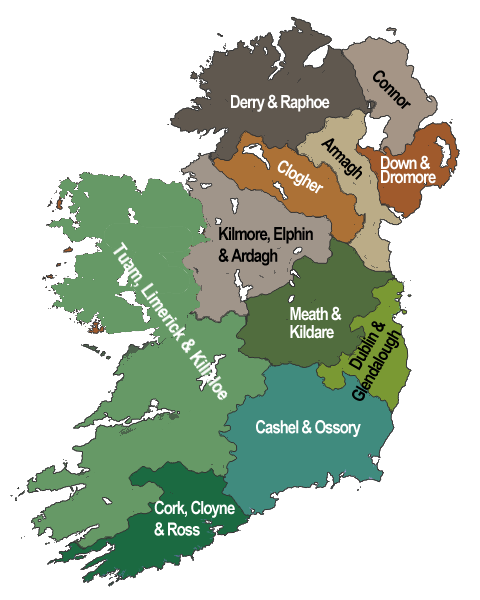Church of Ireland: aka Anglican Catholic Church, Episcopalian Church - Website
The Church of Ireland is a Christian church in Ireland and an autonomous province of the Anglican Communion. It is organised on an all-Ireland basis and is the second-largest Christian church on the island after the Catholic Church. Wikiwand
The Church of Ireland was decreed the State Church in Ireland in 1536 by an Act of the Irish Parliament. The parishes of the Church of Ireland served as governmental centers for the administration of matters of probate and matrimonial jurisdiction. FamilySearch Wiki
The total membership of the Church of Ireland is around 380,000, 75% of whom live in Northern Ireland.
NI Church of Ireland: PRONI Guide to Church Records. The Church of Ireland was the Established Church in Ireland until disestablishment in 1871. Their baptism and burial records up to that date, and marriage registers before 1845, are public records and, as such, individual pages can be copied. Registers after that date, and all other types of records, remain the property of the Representative Church Body (RCB) and, while copies can be made of individual pages, complete reels of microfilm or entire volumes cannot be copied under any circumstances. Church of Ireland baptism records will often record the child’s name and the father’s full name as well as the mother’s maiden name. The majority of Church of Ireland clergymen also recorded burials as well as baptisms and marriages. Burial registers usually give the name and date of burial, the residence (normally only the townland) and the age of the deceased. It is important to note that Church of Ireland registers often include local families of different denominations. PRONI also holds records for some churches in Cos Cavan, Donegal and Monaghan. (PRONI ref MIC/1/ and CR/1) Public Record Office of Northern Ireland
The Representative Church Body Library in Dublin: The largest collection of registers (including those from some non-parochial ministries such as cathedrals, military chapels or chapels of ease) is held by the Church of Ireland's Representative Church Body Library (RCB Library). The Library holds the oldest surviving Irish parish records – the baptism, marriage and burial registers of St John the Evangelist in Dublin – Its collection grows every year as more parishes hand over their records for safekeeping. Personal visitors to the Library may freely access the registers. Irish Genealogy Toolkit
The Church of Ireland was the State church up to 1869.
- They kept burial registers for the parish.
- Surviving parish registers usually start much earlier than RC parish registers, often in the 1700s, sometimes earlier. Parish Register List Website
- 63% of all historic records of the Church of Ireland were destroyed in 1922.
- Those parish records that survive are usually held in the local parish or in one of the national cultural institutions. (National Archives of Ireland, Representative Church Body Library, Public Records Office of Northern Ireland)
- The List of Church of Ireland Parish Registers
FamilySearch Handout.pdf
How to trace your Roots back to the 1830's or earlier. By Fiona Fitzsimons. Eneclann
The Church of Ireland has 12 dioceses and over 450 parochial units covering the whole of Ireland including both the Republic and Northern Ireland.
Anglicans Online - 2 Provinces with 12 Dioceses - Find a church - Website
Province of Armagh - consists of seven dioceses:
Province of Dublin - consists of five dioceses:
Brief History
The Church of Ireland traces its history to the early Irish Church founded by St Patrick. The early Irish Church was primarily monastic in nature but gradually a diocesan structure took shape and bishops assumed increasing authority.
In 1534, the English Parliament declared Henry VIII head of the Church of England in response to the refusal of the Pope to grant an annulment of his marriage to Catherine of Aragon. Two years later, the Irish Parliament declared him head of the Church of Ireland. Initially the dispute was a jurisdictional one and while Henry desired independence from the Papacy, he was theologically catholic. However, Henry VIII’s successors, Edward VI (1547–1553) and Elizabeth I (1558–1603) were more reform–minded and their reigns marked the introduction of Protestantism to both the Church of Ireland and the Church of England.
The reformation split the Irish church. The established Church of Ireland was protestant, state approved and supported. The Roman Catholic Church was regarded with hostility and suspicion by the authorities but nevertheless supported by the majority of the people, particularly outside Dublin, where the crown’s authority was weakest. Each church maintained it was the authentic successor of the pre–reformation Irish church. The plantations of Ulster in 1610 saw the introduction of Presbyterianism to Ireland. The fourth major Christian church in Ireland today, the Methodist church, dates from the first visit to Ireland by John Wesley in 1747.
Although a minority, the Church of Ireland remained the established Church until the UK Parliament’s passage of the Irish Church Act 1870. The Act disestablished the Church of Ireland and separated it from the Church of England. It also provided that the Church of Ireland would be self governing and have no connection with the crown or the state. To provide for its own government, the Church of Ireland created a General Synod, comprising about 650 elected clergy and laity, along with the bishops of the Church. The Church of Ireland was one of the first Anglican Churches to adopt this form of Government and it was to prove a model for Anglican churches worldwide. The Irish Church Act also provided for a ‘Representative Church Body’, consisting of elected clergy and laity to manage the Church’s property and finances and the ‘RCB’ continues to do this today. Churches in Ireland




